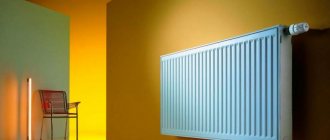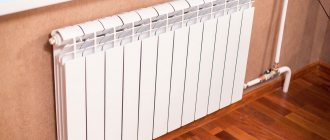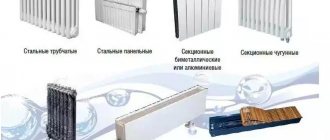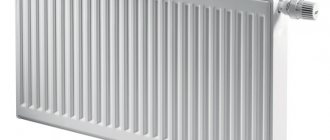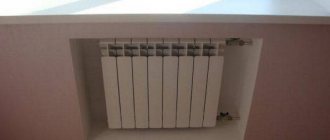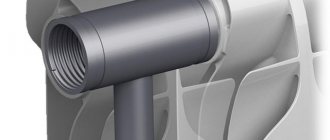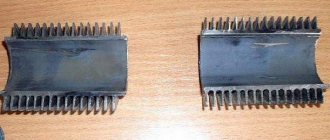The heating radiator market offers a wide range of heating batteries, differing in material, design and external design. Among the wide variety of devices, steel panel radiators occupy one of the leading places in sales. Good heat transfer and ease of installation, a wide range of standard sizes and attractive appearance are what attract the attention of any buyer.
In this material we will tell you everything about panel heating radiators, their distinctive features and design features.
Construction of steel panel radiators
- Structurally, panel radiators consist of several steel panels (from 1 to 3) in which there are vertical and horizontal channels for coolant.
- To increase the heat exchange area and convective heat transfer from the inside, U-shaped steel ribs are welded to the panel. The increase in heat transfer is more than 50%.
- The radiator panel is made by welding two stamped sheets of cold-rolled carbon steel sheet with a thickness of 1.2 mm - 1.25 mm. Some manufacturers make radiators from galvanized steel on special order. For convective heating fin plates, steel with a thickness of 0.4mm - 0.5mm is used.
- The outside of the radiators are primed using the cataphoretic immersion method and painted using the powder method. The standard color is white, but some manufacturers produce colored panel radiators on special order.
- Panel radiators with two or three panels usually have decorative grilles on top and solid panels on the sides.
- The standard radiator is equipped with four lateral connecting pipes 4x1/2″ BP, two on each side. To connect the radiator, two pipes are used, and the remaining two are closed with plugs.
How to increase the performance of already installed batteries
Cost 45-150 rub.
An indispensable element of the heating system is the Mayevsky valve.
Many modern radiators come with it included, otherwise you can buy it in addition and easily install it yourself.
The device is mounted in the upper radiator plug, opposite the coolant supply, and makes it easy to eliminate airiness, which results in a significant reduction in heat transfer.
Some resort to the “folk method”, installing heat-reflecting screens made of foil or metal with corrugated ribs between the battery and the wall.
The most effective method is to install additional sections, but this should only be done when the heating system is completely turned off and the additional load from the added sections should be taken into account.
Types of steel panel radiators
By the presence of convective ribs
There are panel radiators with convective fins and hygienic panel radiators without convective fins.
Hygienic radiators are characterized by easy access to the inside of the radiator to clean it from dust and are usually produced without decorative grilles. These radiators are popular in hospitals and other areas with high hygienic requirements.
By connection method
There are classic radiators with side connections and radiators with bottom connections.
The bottom-connected radiator has two additional lower pipes measuring 2x3/4”HP or 2x1/2”F with a center distance of 50mm and a built-in thermostatic valve insert. The thermostatic head is not included in the standard delivery package and must be purchased separately. Radiator pipes with bottom connections are standardly located in the lower right corner (pictured). Radiators with a central bottom connection and with pipes in the left corner are also produced (marked L - left)
By type of front panel
The following types of panel radiators are distinguished:
- Ribbed surface is standard
- Flat smooth surface (Plano)
- Flat surface with horizontal (pictured) or vertical grooves
Radiators with a flat front panel are made by gluing a decorative panel to a standard profiled panel.
Standard sizes of steel panel radiators
Steel panel radiators are distinguished by a very large number of standard sizes.
- Panel radiator type
This parameter is specified by 2 digits: the first indicates the total number of panels, and the second indicates the number of heating panels with fins. For example, a type 21 steel panel radiator means that the radiator has two panels, including one panel with convective fins. Hygienic radiators have types: 10, 20, 30
- Dimensions of panel radiators
Panel radiators are characterized by a wide range of heights and lengths:
- Overall height of radiators: 200, 300 , 400, 450, 500 , 550, 600 , 900mm. The most popular sizes are highlighted.
- Overall length of radiators: from 400 to 3000 mm in increments of 100 mm.
- Mounting height of panel radiators
The mounting height is the center-to-center distance between the side radiator connection pipes. The installation height value is obtained by subtracting a fixed value from the overall height of the radiator, which varies for different manufacturers. For example, values for the most popular panel radiators:
- Purmo – 50mm
- Kermi - 54mm
- Vogel & Noot - 54mm
- Prado - 50mm
- Lideya - 56mm
Features of tubular batteries
Due to their higher cost, tubular steel batteries are used much less frequently than panel batteries. The design consists of several rows of parallel tubes. In this case, the rows can be located not only horizontally or vertically, but also at an angle.
Characteristics of tubular instruments
Although the operating principle is identical, the methods for manufacturing tubular equipment vary. Some are made in the form of sections, similar to cast iron, which are joined by welding. For others, steel rows of tubes are used, connected at the bottom and top by manifolds.
It is not difficult to turn a tubular heating device into a significant element of room decor
Although the design of tubular radiators varies, almost all models have similar characteristics. This equipment is optimally suited for installation in heating systems in low-rise buildings.
The heat transfer of tubular radiators, compared to panel-type analogues, is greater, but the price is much higher.
Tubular radiators have the following technical characteristics:
- operating pressure 15 atmospheres - during the manufacturing process, 2 tests are carried out - with air for tightness and with water for strength;
- able to withstand significant coolant temperatures - up to 130°C;
- a large selection of dimensions - depth from 40 to 290 mm, height from 190 to 3000 mm, there are no restrictions on length at all;
- for manufacturing they use steel with a thickness of 1.32 to 1.5 mm;
- availability of outlets for side and bottom connections.
The inner walls of tubular devices are most often coated with a polymer composition. This significantly extends their service life. The smooth surface prevents the accumulation of dust, therefore, in terms of hygiene, tubular devices compare favorably with aluminum, cast iron and bimetallic analogues, the cleaning of which causes a lot of inconvenience.
Strengths and weaknesses of batteries
Tubular models of heating devices are appropriate for use in private homes, where the heating system is characterized by a stable and low operating pressure in the absence of sudden surges and water hammer.
The popularity of tubular devices is due to a set of their positive qualities:
- high working pressure and ability to withstand water hammer;
- resistance to mechanical damage due to the absence of gaskets in welded sections;
- uniform heating of the surface and high heat transfer;
- smooth surface prevents dust accumulation;
- ease of installation , possibility of bottom and side connections, various placement options;
- possibility of temperature adjustment when equipped with a thermostatic valve.
In addition to fasteners, tubular radiators can be equipped with special brackets used as heated towel rails.
There is also a whole category of models classified as design radiators - they are used to create an interior. These devices can be produced in the form of frames for mirrors or railings for stairs. Floor-to-ceiling height models are successfully used for zoning a room.
By giving intricate shapes to heating devices, manufacturers increase the competitive attractiveness of their products. But in steel batteries shaped like railings, the functional load increases
A lot of positive qualities and excellent characteristics inherent in steel heating radiators make their use attractive. Such devices are easy to fit into the interior; they allow you to visually expand the space.
However, we should not forget about the disadvantages of tubular models, which are as follows:
- low resistance to corrosion processes, especially evident when the quality of the coolant is low; Spot welding areas are most susceptible to corrosion.
- high cost.
As for cost, tubular batteries are by no means a budget solution. Their installation is most often resorted to by designers who are not constrained by funds when implementing their projects.
Technical characteristics of steel panel radiators
The main technical parameters of panel radiators are operating pressure, thermal power and operating temperature.
- Working pressure of steel panel radiators
There are two types of steel panel radiators: with a working pressure of 7-8 bar and a working pressure of 10 bar. The test pressure is 2-3 bar higher than the working pressure. Steel panel radiators with a working pressure of 7-8 bar are ubiquitous in Europe, but in Russia, steel radiators with a working pressure of 10 bar, which are specially produced for the Russian market, dominate. The operating pressure in the heating system of low-rise buildings (up to 5 floors) does not exceed 4 bar (atmospheres), and in typical nine-story buildings it is 5 - 7 bar.
In Western Europe, low- and mid-rise buildings predominate, which explains the reduced operating pressure requirements for steel panel radiators. And in Russia, panel radiators are often used in high-rise buildings, where the operating pressure can be 7-10 bar.
- Thermal output of a radiator, also called heat output.
This is the main parameter for a heating device, which shows how much thermal energy the radiator gives off in a certain unit of time. Thermal power is expressed in watts.
The value of thermal power depends both on the design features (fin spacing of convective panels) and the standard size of the device, as well as on the thermal operating conditions of the radiator. According to the EU standard EN442, the standard thermal regime is 75/65/20. Which means: 75 C is the temperature of the water entering the heating system, 65 C is the temperature of the return water, 20 C is the temperature of the air in the room.
If the parameters of the heating system differ from the standard thermal mode 75/65/20, then a recalculation of the thermal power of the panel radiator will be required. To do this, you can use manufacturers' tables, adjustment factors, or a conversion formula. The lower the temperature parameters, the more powerful radiators will be required and vice versa;
- Maximum operating temperature
This parameter is standard for all manufacturers and is 110 °C, which does not allow the use of these heating devices in steam heating systems.
What type of radiator should I choose for a specific room?
The radiator is selected depending on its purpose and the level of heat loss of the heated room. If the purpose requires hygienic performance (especially important for children's rooms or hospital wards), then the heating battery is selected from type 10, 20 or 30, i.e. without convection zones, but only with panels for the possibility of wet cleaning even between the panels of the heating device.
Note! It is recommended to select a heating device with a depth of at least 70% of the width of the window opening. Only in this case will the window be guaranteed to be protected from condensation, as well as from the subsequent formation of fungus and mold.
When choosing the type of steel radiator, as well as its size, the possible heat loss of the room is taken into account (the area of the window opening, the quality of glazing and wall insulation, the location of the room).
For example, for a small room with a wide window without increased sanitary requirements, type 11 of the radiator is most likely suitable.
Features of the use of steel panel radiators
- Steel panel radiators are recommended for use in closed heating systems of both private and modern apartment buildings with heating points or apartment heating with wall-mounted boilers;
- Steel panel radiators are not recommended for use in apartment buildings with central heating (with elevator units) and in private houses with an open gravity heating system;
- Steel panel radiators are the best solution for low temperature radiator heating. This is relevant when using efficient condensing boilers. For the most economical boiler mode, it is recommended to maintain the return temperature at 50-55 C.
In addition, low-temperature heating reduces the heat load on the heating system pipelines. You can safely use a variety of plastic pipes.
What materials are batteries made from?
Radiators not only help create a pleasant temperature in the room, but can also become a real decoration of the room. They differ radically from each other in the material of manufacture.
The following options are in great demand on the heating equipment market:
- aluminum;
- bimetallic;
- cast iron;
- copper;
- steel.
Aluminum appliances are lightweight and have a modern appearance. A characteristic feature is the efficiency of energy resources spent on heating and the ease of installation work. Thanks to the thin walls of the batteries, quick heating and a high level of heat transfer are achieved.
A distinctive feature of the operation of panel devices is the absence of pressure surges, water hammers and temperature changes in the circuits, which are inherent in central heating systems, especially during testing and startup
Bimetallic radiators are models made from steel and aluminum. A successful combination of metals ensures rapid heating and increases the ability to withstand pressure loads. This type of radiator is suitable for both autonomous and central heating systems.
Cast iron equipment is characterized by a high degree of heat transfer, reliability and durability. These are unassuming contours, like those of the old MC-140 models, well known from Soviet times. They also produce more respectable models with modernized and modified surfaces, smoothed inside and out.
Copper batteries are durable, but have a fairly high price. Therefore they are used quite rarely.
Steel heat exchangers are characterized by a simple design, which helps ensure convection heating of the room.
To get to know steel radiators in more detail, you need to understand their classification by type, familiarize yourself with the technical characteristics, features of installation work and operation.
Complete set and installation of steel panel radiators
- Panel radiators are standardly designed for wall-mounted installation and have mounting plates on the rear side. Floor installation is possible; for this you need to buy special floor fasteners.
- Some manufacturers supply their radiators with a basic installation kit, which includes: a set of wall brackets, a plug and a manual air vent (Mayevsky valve).
- Valve-type panel radiators (with a thermostatic valve insert) are supplied without a thermal head, which must be purchased separately.
- For radiators that are supplied without an installation kit, you must purchase the appropriate installation kit.
DIY connection
The radiator is connected to an already finished wall. This means that all finishing (painting, wallpapering) must be completed. The batteries are hung on the wall using hooks or brackets. If the wall is not able to support the weight of the radiator, it is attached to the floor. Special legs are available for sale for this purpose.
The radiator is connected to the heating system using special shut-off devices. They will allow you to turn off the water or set the required temperature at any time. The parts are connected using threaded elements (ball valves, tees, bends). All threaded connections are sealed. If you have the skills, the connections can be secured by welding.
Advantages and disadvantages of steel panel radiators
Advantages of steel panel radiators
- You can select economical models with a minimum price per 1 kW of thermal power;
- A large set of standard sizes makes it easy to select a device of the required thermal power and fit it into the given dimensions;
- Suitable for low-temperature heating, as thanks to convective fins they have high heat transfer; Well amenable to thermal regulation due to low thermal inertia;
- Models are available with various bottom and side connection methods.
Disadvantages of steel panel radiators
- Low corrosion resistance: sensitive to oxygen dissolved in the coolant; Corrosion increases sharply when the heating system is emptied, for example in summer;
- Sensitive to dirt in the coolant - can clog;
- Sensitive to hydraulic shock;
- Working pressure no more than 10 bar;
- Convective heat transfer dominates (75% - convective heat radiation; 25% - radiant radiation). Convective heat transfer involves heating and circulating air in a heated room, which leads to the circulation of dust.
Main characteristics
The main indicators that must be taken into account when choosing a radiator include power and overall dimensions.
Among the wide range of offers you can find models with different dimensions. This allows you to choose the right option for any room and any niche. Models are available with heights from 30 to 90 cm and lengths from 40 to 300 mm.
As the size increases, the power of the device also increases. The power of the most popular batteries can be seen in the table below.
Tips for choosing and using steel panel radiators
- In low-rise (private) and mid-rise buildings, it is advisable to use steel panel radiators with an operating pressure of 8 bar, which will provide significant savings without loss in system reliability.
- The thermostatic insert can be unscrewed and a standard side connection can be made;
- Steel panel radiators of the same type and standard size have similar thermal power values, differing by no more than 10% (which is less than the design margin), the same connection dimensions and a similar design. Therefore, they are completely interchangeable;
- During installation, it is necessary to create conditions for air circulation, so the distance from the radiator to the floor and to the window sill must be at least 100mm;
- Radiators must be installed in the original packaging and this packaging must be removed after all finishing work has been completed.
- When choosing pipeline fittings for connecting panel radiators, you must take into account whether the heating system is single-pipe or double-pipe. For a one-pipe heating system, specialized valves with increased flow capacity (Kv) are needed.
- It is recommended to select radiators based on the expected heat losses of the heated room, and not on the width of the windows. Because in the latter case, you can not only significantly overpay, but also greatly worsen the microclimate in the room. This situation can only be saved by installing radiator thermostats.
Main dimensions of cast iron batteries
Although the main criterion, which is accepted by all manufacturers, is the center distance, there are products that, with the same parameter, have differences in height, depth and width.
Basic indicators:
- The center distance is quite varied. It can vary from 220 mm to 900 mm.
- The height of the cast iron battery ranges from 330 mm to 950 mm.
- The depth is 85-200 mm.
- There are products with a width from 45 mm to 100 mm.
Given such a wide range, all products are divided into low, high and standard cast iron radiators. In each of these model ranges you can find the usual “accordion”, and antique products, and chic palace or Art Nouveau style, or modern samples with a flat outer panel.
As a rule, for low models, a place is found in rooms with panoramic windows, or where the walls are weak, for example, made of plasterboard. Their center distance does not exceed 30 cm, and their height is 38.8 cm. On the domestic market they are represented by models such as MS-110 and 90. Modern low analogues have a basic center distance of almost 40 cm. The most popular are products from such manufacturers as like Bolton220 (Turkey) and Viadrus (Czech Republic) - 34 cm.
The height of a cast iron radiator of a standard size is based on an interaxal distance of 50 cm. If you choose a Soviet “accordion” for an apartment of the usual type, then domestic manufacturers produce them under the following markings: MS-85 and 90, MS-110 and MS-140.
In this segment you can most often find designer models in an antique style. They are expensive, but they look impressive and heat wonderfully.
You should not look for a section size of a cast iron battery that is too high. Although new devices weigh half as much as old ones, radiators made of this metal cannot be found above 1 m. This model range is dominated by cast iron batteries from Demir Döküm (Türkiye). Their designer products are distinguished by their originality, the highest quality of cast iron and high cost.
Before making a choice, you should carefully study the product data sheet and become familiar with its main parameters. Since any installation of radiators is preceded by a calculation of the power based on the area of the room, and their size directly affects this parameter, you should immediately check all the indicators so as not to subsequently purchase or remove sections.
Major manufacturers of steel panel radiators
The Russian market offers products from more than 40 manufacturers of steel panel radiators. The share of imported radiators exceeds 80%, the vast majority of them are European-made.
Main manufacturers and brands of steel panel radiators.
- Rettig Heating (Germany, Finland, Poland): Purmo, Vogel&Noot, Dia Norm
- Kermi (Germany)
- Korado (Czech Republic)
- Prado (Russia)
- Lideya (Belarus)
Manufacturers
Panel radiators made of steel are available on the market in models from various manufacturers. Both domestic and imported products are available. The following companies produce steel panel radiators:
- Kermi (Germany);
- Buderus (Germany);
- "Korado" (Czech Republic);
- DeLonghi (Italy);
- PURMO (Finland).
Panel steel radiators are an excellent choice for an autonomous heating system. They will allow you to heat the room efficiently and quickly. Thanks to their design, they have a high efficiency, can work with coolant of almost any quality, consume a small amount of energy and do not emit harmful and dangerous substances, that is, they are environmentally friendly.
Related products and accessories for steel panel radiators
To connect a panel radiator, that is, radiator piping, specialized pipeline fittings are used.
- To supply coolant to a radiator with a side connection, radiator valves with a detachable connection are used, which allow the radiator to be removed if necessary. You can choose a manual radiator valve or a thermostatic valve for which you will also need to purchase a thermal head.
- To connect the return line, a check radiator shut-off valve with a detachable connection is used.
- For radiators with bottom connections, special units with a union nut are used, which have built-in ball valves.
- If it is necessary to organize the bottom connection of a standard radiator with side connecting pipes, then use special headsets for the bottom connection.
- For floor mounting of panel radiators, special floor brackets are used.
- For wall mounting, instead of the simple brackets included in the basic kit, you can use Monclac type rail brackets, which simplify the process of installing and dismantling the radiator.
- Purmo is promoting the Purmo Air ventilation kit, which purifies outside air and then heats it with a steel panel radiator.
Prices: summary table
| Manufacturer and model | Working pressure, atm | Heat dissipation, W (at 70°C according to GOST 31311-2005) | Coolant volume in the radiator, l | Price, rub | Cost of 1 kW of power, rub |
| Panel | |||||
| Kermi FTV(FKV) 22 500 500, Germany | 10 | 965 | 2,7 | 5 300 | 5 492,2 |
| Buderus Logatrend K-Profil 22 500 500, Germany | 10 | 913 | 3,15 | 2 600 | 2 847,8 |
| ELSEN ERK 22 500 500, Czech Republic | 10 | 1158 | 2,7 | 3 600 | 3 108,8 |
| Prado Classic 22 500 500, Russia | 9 | 874 | 2,82 | 3 200 | 3 661,3 |
| Lemax (Lemax) C22 500×500, Russia | 9 | 1102 | 2,82 | 3 500 | 3 176,0 |
| Purmo Compact 22 500 500, Finland | 10 | 735 | 2,75 | 3 500 | 4 761,9 |
| Tubular | |||||
| Zehnder Charleston 3050 500 1196, Germany | 10 | 1352 | 20,8 | 29 000 | 21 449,7 |
| Arbonia 2180 1800 540, Germany | 10 | 1560 | 18,72 | 25 000 | 16 025,6 |
| Sunerzha Estet 500 5008, Russia | 25 | 1264 | — | 50 000 | 39 556,9 |
| KZTO RS 2-500 1150, Russia | 15 | 1960 | 11,2 | 15 000 | 7 653,1 |
| Dia Norm Delta Standard 3057 1000, Germany | 10 | 1240 | 18,2 | 30 000 | 24 193,5 |
A heating system made from tubular radiators is much more expensive than panel radiators, although it has slightly better characteristics. Even the most budget options are more expensive than bimetallic radiators with much more serious characteristics, which is why they are so rarely used.
As for panel batteries, we recommend taking care first of all about reliability and choosing German or Finnish models that have been proven for several decades: Kermi FKV 22, Purmo Compact 22 or Buderus Logatrend K-Profil 22. In addition, the latter combine high quality, and an affordable price compared to analogues.
Calculation of the power of batteries, heating radiators
The first thing you need to know is that when calculating the type of heating device, it does not matter whether it is cast iron, aluminum, steel or made of bimetal. The main indicator is the power of the unit. All manufacturing companies must indicate the thermal power of radiators. In case of emergency, knowing the model of the unit, you can always find technical data on the Internet. A little advice: some manufacturers may significantly inflate this figure.
The second thing you need to know is the area of the room that you need to heat. It is important to remember that calculating battery power
must be performed not for the total area of a private house, cottage or apartment, but for each room separately.
Third, the formula for calculating the power of heating batteries
It is extremely simple and anyone can use it. According to SNiP, per 1 square meter of a room with an average ceiling height (2.7 meters) there is 100 W of thermal power. Therefore:
- K – number of sections
- S – area
- P – radiator power
Example: calculating radiator power
for a room of 30 square meters with a standard ceiling height of 2.7 meters. The average power of one section is 180 W. We use the calculation formula: K = 30 * 100 / 180 = 16.7 pieces. Round up to 17, that is, you need 17 sections.
Production of tubular radiators
To manufacture tubular radiators, the stamping method is used, but there are several models of similar devices, and each of them has its own manufacturing technology. For example, the first category of product is created from straight pipes of different diameters and installed vertically. In this case, the connection of individual pipes is carried out using horizontal collectors. Another category has a sectional design that externally resembles conventional cast iron products, but in the case of steel radiators, the connection of their elements is carried out by welding.
The production technology of tubular heating radiators is as follows:
- Steel sheets about 2 mm thick go through a stamping stage, resulting in half of the radiator sections;
- The workpieces are connected to each other by resistance welding;
- The welded sections are thoroughly cleaned of various burrs and roughness that arose during the welding process;
- The individual sections are attached to each other using a welded joint so that a solid product is obtained;
- The welding seams are ground again, after which the radiators undergo a leak test using special equipment;
- Assembled and tested radiators are painted, the technology of which looks exactly the same as in the case of panel devices;
- The last stage of manufacturing tubular radiators involves sending them for heat treatment to melt the epoxy coating.
Sectional steel heating radiators are manufactured using a slightly different technology:
- First of all, pipes of suitable length are cut to be used as convectors;
- The lower part of the pipes is hermetically sealed, while the upper part remains open;
- Using spot welding, pipes are connected to horizontal collectors through which the coolant passes;
- All welds on radiators must be sanded, after which the prepared products are sent for painting;
- In some radiator models, the upper edges of the convectors are decorated with nickel-plated rings.
The variety of tubular steel radiators is not limited to the options already described - there are also more interesting designs that allow you to implement any design solution. Some types of tubular products are hollow panels connected to collectors that provide coolant movement.
Power and number of sections
The power of steel radiators is determined during production by the manufacturer itself: it is set according to the type of radiator - 11, 22 and 33 - and height - from 300 to 900. The power indicator will be determined directly by these values: as a rule, 1 section works per 1 m2 of heated area premises.
Factors for calculation
The calculation of steel radiators begins with determining the climate: for temperate - a variation of 60-100 W/m2, for northern regions - the norm is from 150-200 W/m2. These calculation sources rarely produce errors. The second criterion for calculation is heat transfer, which can be seen on the packaging or data sheet.
The height of the ceilings also matters - the standard value is 2.7 m, if more or less, then you need to adjust accordingly. To do this, the actual ceiling height is divided by 2.7, and the resulting coefficient is multiplied by the standard power. It is important to remember that when doing it yourself, it is better to take power with a reserve: the heat will “go away” to corner rooms, thin walls and other nuances that a simple user will not be able to take into account.
Simple formula
The calculation is carried out in several stages. An average power value of 100 watts per 1 m2 is taken. If the area of the house is 30 m2, and the power of 1 section of the battery is 180 watts, then the calculations will be as follows: 30 * 100/180, a total of 17 sections will be required to heat a space of 30 m2. If this is a corner room, then this value is multiplied by a factor of 1.2 - i.e. 20 radiator sections.
Heating devices are installed in almost every living space. Usually these are Soviet cast iron batteries, modern aluminum or bimetallic radiators. The house will be warm and cozy if the heating radiators are calculated
and well made.
Depends on several factors:
- technical feasibility of an autonomous or centralized heating system
- coolant quality
- individual choice of the customer, taking into account his idea of the quality of this device
- price policy
Correct calculation of the number of radiators
will provide a favorable microclimate in a heated building. It will provide the owner with the opportunity to independently regulate the temperature in the room. Will help in selecting the ideal heating equipment for your interior. This will be done with optimal calculation of radiators.
Every year the winters in our country become more severe, and many people are increasingly thinking about or installing an additional new one. Every third buyer wants to do it on their own. To do this, they have to face the issue of the size and calculation of heating radiator sections
. Next we will take a closer look at this issue.
Advantages
Large working area of panel radiators provide high thermal output .
If there are several panels in the design, heat transfer increases, which allows you to get a more powerful device without taking up additional space in the room. Also, unlike sectional models, panel structures have great resistance to mechanical damage , which is achieved by minimizing the connection points of individual elements.
If we compare steel batteries with cast iron ones, the former have significantly less weight , which expands the scope of their application. They can be mounted on walls lined with plasterboard without worrying about compromising the integrity of the material. The advantage of steel batteries over aluminum ones is their electrical corrosion resistance.
In addition, the important advantages of steel models , the design of which consists of panels, are the following factors :
- low cost,
- wide size range,
- low thermal inertia (small amount of coolant),
- ease of installation,
- high-tech design,
- easy to clean (but do not use abrasive cleaners).
Precautionary measures
- When installing a steel battery yourself, the tap opens gradually to prevent water hammer.
- It is advisable to install the air valve in the top hole.
- In summer and spring-autumn, a small amount of coolant is present in the heating pipes. A heating device without water should not be idle for more than 15 days a year.
- Transport, install, and store carefully to avoid mechanical damage or chipping of the paintwork. Protect from damp environments and exposure to alkaline and acidic environments.
- Consider the coolant recommended by the radiator manufacturer.
Advertising from sponsors: // // //
Classification
Steel batteries are available in three types:
- tubular - welded structure made of pipes with a working pressure of up to 15 atmospheres;
- sectional - durable sections are connected by spot welding, operating pressure up to 16 atmospheres;
- panel ones are the most popular, they are made of two welded rectangular sheets with stamped recesses.
In panel pipes, the operating pressure reaches 13 atmospheres at a coolant temperature of no more than 110 degrees.
